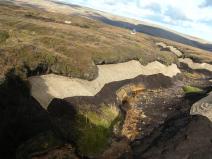MoorLIFE, one of the largest conservation projects in the UK, is now spreading thirty-three kilometres (more than twenty miles) of geo-textile netting on to the moor surface of Bleaklow to help reduce erosion of the peat and establish a new layer of vegetation. The Bleaklow conservation work site, stretching between the cities of Sheffield and Manchester, is so extensive it will be clearly seen by air passengers flying in and out of local airports.
Bio-degradeable geo-textiles look like large fishing nets. It is airlifted by helicopter in bales on to Bleaklow Moor to selected areas of bare peat. It is then spread by local contractors and pegged on to bare-sided haggs and groughs (deep eroded channels carved into the peat) to reduce erosion and also trap sown seed to help increase vegetation on these steep sided areas.
Chris Dean, programme manager, Moors for the Future Partnership, said: “It’s inspiring to see the scale of the works from the air – it looks like large rivers of material protecting the peat. Over time, when the vegetation has been restored, the geo-textiles will break down and decay leaving behind a more healthy moorland, producing a great result for wildlife and people.”
